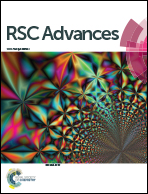A simple nanoporous silica-based dual mode optical sensor for detection of multiple analytes (Fe3+, Al3+ and CN−) in water mimicking XOR logic gate†
Abstract
A simple but versatile nanoporous silica-based optical sensor was synthesized and characterized using different techniques such as XRD, BET, TGA, and FT-IR. The sensing ability of the sensor was examined upon addition of a wide variety of cations and anions in water both visually and by fluorescent spectroscopy. The color of the water suspension of the sensor changed from beige to brown in the presence of the Fe3+ ion and its fluorescence intensity enhanced upon addition of Al3+ and CN− following excitation at λ = 390 nm. The rest of the tested ions neither induce remarkable changes in the optical properties of the sensor nor interfere in the detection of the target ions indicating the selectivity of the sensor toward the detected ions. Linear changes of the optical properties of the sensor as a function of the concentrations of the target ions was proved. The detection limits for all three ions were also calculated. Finally, investigation of the logic behavior of the sensor revealed its capability of functioning as a XOR-type fluorescent sensor with Al3+ and CN− ions as inputs.


 Please wait while we load your content...
Please wait while we load your content...